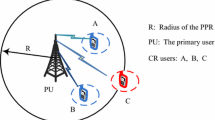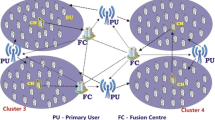Abstract
Cognitive radio (CR) can significantly enhance spectrum efficiency by dynamical accessing the licensed spectrum. However, single user spectrum sensing may be inaccurate and the second user (SU) may preempt the channel of the primary users (PUs). The appearance of cooperative spectrum sensing (CSS) can effectively improve the spectrum sensing performance by fusing the results of multiple SUs’ decisions to yield reliable decisions. Nevertheless, the communication overhead and the energy consumption of SUs bring a heavy burden for the resource limited secondary network. Therefore, in this paper, we propose a correlation based scheme to select representative SUs based on their correlation by using improved Density-Based Spatial Clustering of Applications algorithm (DSCN). First, we set a threshold to screen out SUs with good channel quality. Then, we propose a improved DSCN algorithm to select SUs that participate in CSS. This algorithm can select representative SUs based on their correlations. Simulation results show that the sensing overhead has been greatly reduced and the probability of detection and the probability of false alarm are better than the traditional spectrum sensing schemes.
This work was supported in part by the National Natural Science Foundation of China under Grant 61941119, Grant 61901379, Grant 61901381, and Grant 61901378, in part by the China Postdoctoral Science Foundation under Grant BX20180262, Grant BX20190287, and Grant 2018M641019, in part by the Natural Science Basic Research Plan in Shaanxi Province under Grant 2019JQ-631, and Grant 2019JQ-253, in part by the National University Student Innovation and Entrepreneurship Training Programs No. 201910699119, in part by Foundation of the Science, Technology, and Innovation Commission of Shenzhen Municipality under Grant JCYJ20190806160218174, in part by the open research fund of National Mobile Communications Research Laboratory, Southeast University under Grant 2020D04.
Y. Zhang and W. Zhao—The first two authors contributed equally to this work.
Access this chapter
Tax calculation will be finalised at checkout
Purchases are for personal use only
Similar content being viewed by others
References
Federal Communications Commission: Spectrum policy task force report, FCC 02-155 (2002)
Mitola, J., Maguire, G.Q.: Cognitive radios: making software radios more personal. IEEE Pers. Commun. 6, 13–18 (1999)
Mehdawi, M., Riley, N., Fanan, A., Bentaher, O.: Proposed system model for wideband cooperative spectrum sensing with multi-bit hard decision using two-stage adaptive sensing. In: IEEE 2019 27th Telecommunications Forum (TELFOR), Belgrade, Serbia, pp. 1–4 (2019)
Kartlak, H., Odabasioglu, N., Akan, A.: Optimum relay selection for cooperative spectrum sensing and transmission in cognitive networks. In: 22nd European Signal Processing Conference (EUSIPCO), Lisbon, pp. 161–165 (2014)
Smriti, Charan, C.: Double threshold based cooperative spectrum sensing with consideration of history of sensing nodes in cognitive radio networks. In: IEEE 2018 2nd International Conference on Power, Energy and Environment: Towards Smart Technology (ICEPE), Shillong, India, pp. 1–9 (2018)
Chandrasekaran, G., Kalyani, S.: Performance analysis of cooperative spectrum sensing over \(\kappa {-}\mu \) shadowed fading. IEEE Wirel. Commun. Lett. 4(5), 553–556 (2015)
Yang, J., Shao, X.: Optimal number of secondary users in weighted cooperative spectrum sensing. In: Proceedings of 2011 Cross Strait Quad-Regional Radio Science and Wireless Technology Conference, Harbin, pp. 902–905 (2011)
Rifa-Pous, H., Blasco, M.J., Garrigues, C.: Review of robust cooperative spectrum sensing techniques for cognitive radio networks. Wirel. Pers. Commun. 67(2), 175–198 (2012). https://doi.org/10.1007/s11277-011-0372-x
Peh, E., Liang, Y.-C.: Optimization for cooperative sensing in cognitive radio networks. In: Proceedings of the IEEE Wireless Communications and Networking Conference (WCNC), Hong Kong, pp. 27–32 (2007)
Gudmundson, M.: A correlation model for shadow fading in mobile radio. Electron. Lett. 27, 2146–2147 (1991)
Dhurandher, S.K., Woungang, I., Gupta, N., Jain, R., Singhal, D., Agarwal, J., et al.: Optimal secondary users selection for cooperative spectrum sensing in cognitive radio networks. In: IEEE Globecom Workshops (GC Wkshps), pp. 1–6 (2018)
Author information
Authors and Affiliations
Corresponding author
Editor information
Editors and Affiliations
Rights and permissions
Copyright information
© 2021 ICST Institute for Computer Sciences, Social Informatics and Telecommunications Engineering
About this paper
Cite this paper
Zhang, Y., Zhao, W., Wang, D., Zhai, D., Tang, X. (2021). Correlation Based Secondary Users Selection for Cooperative Spectrum Sensing Network. In: Li, B., Li, C., Yang, M., Yan, Z., Zheng, J. (eds) IoT as a Service. IoTaaS 2020. Lecture Notes of the Institute for Computer Sciences, Social Informatics and Telecommunications Engineering, vol 346. Springer, Cham. https://doi.org/10.1007/978-3-030-67514-1_6
Download citation
DOI: https://doi.org/10.1007/978-3-030-67514-1_6
Published:
Publisher Name: Springer, Cham
Print ISBN: 978-3-030-67513-4
Online ISBN: 978-3-030-67514-1
eBook Packages: Computer ScienceComputer Science (R0)




